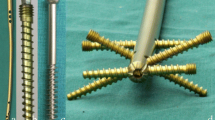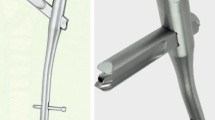Summary
This retrospective consecutive clinical series describes our satisfactory experience with reamed intramedullary femoral nailing in the treatment of nonunions, axial or rotational deformities as well as length discrepancies following the primary treatment of femoral shaft fractures. 31 patients (32 fractures) treated at our institution from 1992 to 1997 were reviewed for age, gender, cause of injury, type of femur fracture, primary treatment, indication for secondary nailing, operative procedure, complications, need for additional procedures and time for consolidation. 3 patients were lost for follow-up, leaving 28 patients (29 fractures) for evaluation. The average follow-up was 79 weeks (range 24 to 192). The indications for secondary nailing were: 18 nonunions, 7 rotational or axial deformities, 4 length discrepancies. Consolidation was achieved in 25 patients (26 fractures) at an average time of 38 weeks (range 12 to 104). Nonunion was recorded in 3 patients. They were treated successfully with an additional procedure (one exchange intramedullary nailing and two autologous bone grafts). The reamed intramedullary interlocking nail offers many advantages, especially a good initial and middle term stability which is important in case of a slow process of consolidation. By the treatment of atrophic and long lasting nonunion, simultaneous bone grafting seems to be indicated. We conclude that interlocking reamed femoral nailing is a safe treatment option for nonunions and malunions following primary treatment of femoral shaft fractures, resulting in successful union without additional procedure in 26 of 29 fractures in this series.
Similar content being viewed by others
References
Baumgart F, Kohler G, Ochsner PE (1998) The physics of heat generation during reaming of the medullary cavity. Injury 29 [Suppl 2]: B11–25
Bötsman O, Varjonen L, Vainionpää S, Majola A, Rokkanen P (1989) Incidence of local complications after intramedullary nailing and after plate fixation of femoral shaft fractures. J Trauma 29: 639–645
Cheng JCY, Tse PYT, Chow YYN (1985) The place of the dynamic compression plate in femoral shaft fractures. Injury 16: 529–534
Cole JD (1996) The vascular response of bone to internal fixation. The Science and Practice of Intramedullary Nailing, 2nd ed, Browner BD, Williams & Wilkins, Baltimore 43–69
Cove JA, Lhowe DW, Jupiter LB, Siliski JM (1996) The management of femoral diaphyseal nonunions. J Orthop Trauma 11: 513–520
Gärtner J, Rudolph H (1987) Die Femurschaftfraktur: Behandlung und Ergebnisse von 209 Frakturen. Unfallchirurg 13: 99–105
Gustilo RB, Anderson J (1976) Prevention of infection in the treatment of one thousand and twenty-five open fractures of long bones: Restrospective analysis. J Bone Joint Surg 58A: 453–458
Gustilo RB, Mendoza RM, Williams DN (1984) Problems in the management of type III (severe) open fractures: A new classification of type III open fractures. J Trauma 24: 742–746
Hak DJ, Lee SS, Goulet JA (2000) Success of exchange reamed intramedullary nailing for femoral shaft nonunion or delayed union. J Orthop Trauma 14: 178–182
Harper MC (1984) Ununited fractures of the femur stabilized with the fluted rod Clin Orthop 190: 273–278
Heiple KG, Figgie HE III, Lacey SH, Figgie MP (1985) Femoral shaft nonunion treated ba a fluted intramedullary nail. Clin Orthop 194: 218–225
Henry SL, Adcock RA, Von Fraunhofer A, Seligson D (1987) Heat of intramedullary reaming. Southern Med J 80: 173–176
Johnson EE (1994) Acute lengthening of shortened lower extremities after malunion or nonunion of a fracture. J Bone Joint Surg 76A: 379–389
Kempf I, Grosse A, Abalo C (1986) Locked intramedullary nailing. Its application to femoral and tibial axial, rotational, lengthening and shortening osteotomies. Clin Orthop 212: 165–173
Kempf I, Grosse A, Rigaut P (1986) The treatment of noninfected pseudarthrosis of the femur and tibia with locked intramedullary nailing. Clin Orthop 212: 142–154
Kenedi RM (1980) Biomedical engineering. Edinburgh: Blackie & Son 54–60
Klemm KW (1986) Treatment of infected pseudarthrosis of the femur and tibia with an interlocking nail. Clin Orthop 212: 174–181
Krettek C, Miclau T, Blauth M, Lindsey RW, Donow C, Tscherne H (1997) Recurrent rotational deformity of the femur after static locking of intramedullary nails. J Bone Joint Surg 79B: 4–8
Küntscher G (1949) Die Marknagelung der Pseudarthrose. Monatsschr Unfallheilkd 52: 1–15
Leighton RK, Waddell JP, Kellam JF, Orrell KG (1986) Open versus closed intramedullary nailing of femoral shaft fractures. J Trauma 26: 923–926
Müller CA, Baumgart F, Wahl D, Perren SM, Pfister U (2000) Technical innovations in medullary reaming: reamer design and intramedullary pressure increase. J Trauma 49: 440–445
Müller ME, Nazarian S, Koch P, Schatzker J (1990) The comprehensive classification of fractures of the long bones. Springer, Berlin Heidelberg, New York, Tokyo
Oh I, Nahigian SH, Rascher JJ, Farkall JP (1975) Closed intramedullary nailing for ununited femoral shaft fractures. Clin Orthop 106: 206–215
Okhotosky VP, Souvalyan AG (1978) The treatment of non-union and pseudarthrosis of the long bones with thick nails. Injury 10: 92–98
Riquelme AG, Rodriguez AJ, Mino GL, Sanmartin RM (1992) Treatmenrt of the femoral and tibia fractures with Grosse and Kempf locking nails. Clin Orthop 283: 86–89
Schwarzkopf W, Kirschner P, Ahlers J (1981) Vergleichende klinische Untersuchungen nach Femurschaftosteosynthesen mit Marknagelung oder Platte. Unfallheilkd 153: 204–205
Seiler JG, Swiontkowski MF (1991) A prospective evaluation of the AO/ASIF universal femoral nail in the treatment of traumatic and reconstructive problems of the femur J Trauma 31: 121–126
Stewart RL (1998) Temperature elevation in cortical bone during intramedullary reaming:the effect of intermittent IM irrigation and sharp reamers. Presented at the Annual Meeting of the Orthopaedic Trauma Association, Vancouver, Canada
Tencer AF, Johnson KD (1994) Biomechanics in orthopedic trauma. London: Martin Dunitz
Thompson F, O'Beirne J, Gallagher J, Sheehan J, Quinlan W (1985) Fractures of the femoral shaft treated by plating. Injury 16: 535–538
Tornetta P III, Tiburzi D (2000) Reamed versus nonreamed anterograde femoral nailing. J Orthop Trauma 14: 15–19
Webb LX, Winquist RA, Hansen ST (1986) Intramedullary nailing and reaming for delayed union of the femoral shaft. Clin Orthop 212: 133–141
Weise K, Winter E (1996) Die Rolle des Marknagels bei Pseudarthrosen und Fehlstellungen. Orthopäde 25: 247–258
Weresh MJ, Hakanson R, Stover MD, Sims SH, Kellam JF, Bosse MJ (2000) Failure of exchanfge reamed intramedullary nails for ununited femoral shaft fractures. J Orthop Trauma 14: 335–338
Wich M, Veltin J, Hollen I, Letsch R (1999) Multidimensional corrective osteotomy of the distal femur using a retrograde femoral nail. Unfallchirurg 102: 652–655
Winquist RA (1986) Closed intramedullary osteotomies of the femur. Clin Orthop 212: 155–164
Winquist RA, Hansen ST Jr, Clawson DK (1984) Closed intramedullary nailing of femoral fractures: A report of five hundred and twenty cases. J Bone Joint Surg 66A: 529–539
Wu CC, Shih CH (1992) Treatment of 84 cases of femoral nonunion. Acta Orthop Scand 63: 57–60
Author information
Authors and Affiliations
Rights and permissions
About this article
Cite this article
Crevoisier, X., Mouhsine, E. & Chevalley, F. The role of reamed intramedullary nailing in the treatment of nonunions and malunions following femoral shaft fractures. Eur J Orthop Surg Traumatol 11, 91–96 (2001). https://doi.org/10.1007/BF01682485
Received:
Accepted:
Issue Date:
DOI: https://doi.org/10.1007/BF01682485




